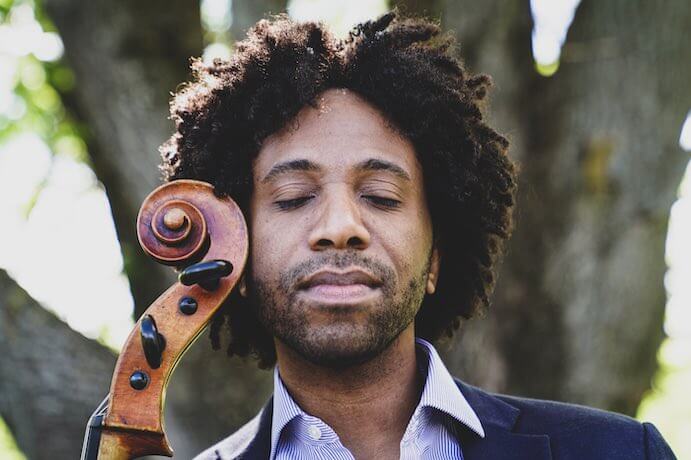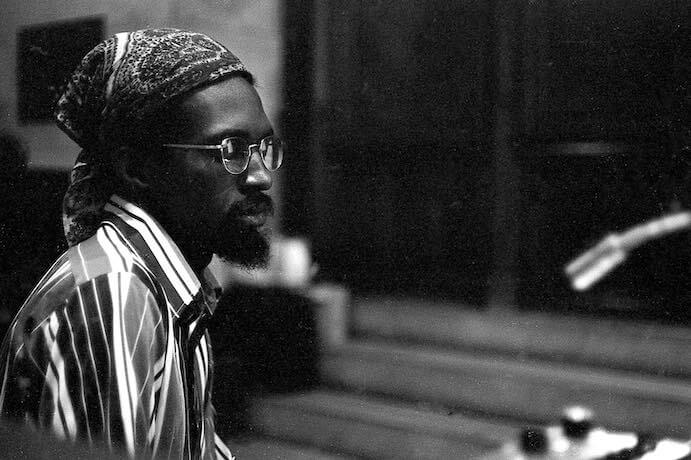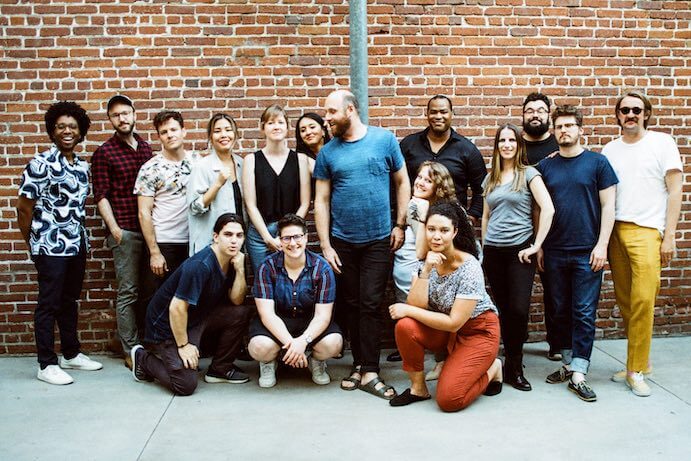Wild Up’s premiere studio recording of Julius Eastman’s Femenine on New Amsterdam Records is the beginning of a years-long project to anthologize his work. Given the past year’s heightened attention to anti-racism, it’s only fitting to revive the works of a gay Black composer who can hardly be found in the canon. Significant about this release is the fact that Julius Eastman died in 1990, unbefitting the tradition of New Amsterdam Records recording living composers. This in itself meets the growing calls for minority inclusion in classical music. Largely invisible composers like Julius Eastman can finally be acknowledged as having lived at all.
Among those who have already been paying homage to the life of Julius Eastman is Seth Parker Woods, a bandleader and cellist on this project. Parker Woods prefers that the composer not be remembered by his struggle with addiction and homelessness. It’s his musical genius—in the same way Beethoven and Mozart are remembered—in which Eastman’s legacy should be enshrined, says Parker Woods. Ahead of the June 18, 2021 release of Julius Eastman Vol. 1: Femenine on New Amsterdam Records, Seth Parker Woods offered his perspective for what this project means to him and the impact he hopes it will have.
How has your connection to Femenine evolved since your 2018 performance of it at the Colburn School?
Great question! 2018 marked the two year anniversary of my return to the United States after a long sojourn in Europe. Around the same time of that concert, I took part in The Kitchen’s expansive retrospective that aided in rekindling the Eastman’s legacy. Seeing his many admirers share stories and perform his works that up till then I had yet to hear live shook something within me. Fast forward to May 2018, my colleagues and I at Monday Evening Concerts in Los Angeles were preparing to present Femenine for the first time on the West Coast. Leading up to the performance, there were still so many questions regarding form, the role of the bells, the evolution of rhythmic and harmonic material, and most importantly, the performative interchange between the performers.
In listening back to that performance, I realize just how brilliant Eastman was. Femenine is a work and experience like so many of his compositions, that prioritises the agency of the performer to actively make subjective/collective choices which will inform and alter the music’s internal landscape. In 2021, my relationship has only deepened from a distance with Femenine. When Wild Up began working on the piece back in 2019, I really wanted to make sure we understood the form, the subtle shifts from one cell to the next, and the internal interplay between musicians—a sense of trust must be there so that the rest can take care of itself. I personally think over-analysing each musical cell goes against the nature of this work. On a macro level, you learn the most about “how to play Eastman” simply by doing so in concert. A different layer of ecstasy, joy, and focus occurs during the act of performing, and it is during that time that one fully understands what Eastman has constructed and what he wants you to learn from it. All that is to say, I am more hands off at this point and just want to make sure everyone in the group trusts each other to collectively carry the music to the end.

Seth Parker Woods–Photo by James Napoli
What makes Eastman’s music more relevant today as increasing attention is given to underrepresentation in classical music?
To be very honest, his music should have been more relevant and celebrated in his time, but alas, many of the same “gate keeper” systems surrounding the classical sphere are alive and well today. Eastman’s relevance is based on his authenticity and willingness to bare all of himself in his work and try out different idioms, whether they be blues sonorities, liturgical quotations, or Patti Smith-inspired bass lines. He wasn’t afraid to use popular music inflections in his work, and that type of risk-taking in our field–combined with an absolute mastery and understanding of harmony, tension and form–is what makes his music successful. He embraced genre-fluidity for the sake of expression that didn’t come off as forced, and that is why so many have flocked to him. He has inspired a new breed of artists, and his very existence shows that someone of the past renounced the cages of a system we’ve all been taught, and succeeded in doing what we are now attempting at this very moment.
However, it is not lost of me that he wasn’t the only one creating such genre-fluid music in his time, but Eastman’s entire persona is woven throughout his work, and that seems to be what the public has lauded and embraced. As overdue attention is being directed towards underrepresented creative groups and individuals, I think it’s important that the public resist boxing their outputs into something from the inherited canon. These creative’s works are their own, and are innovations based on their present and past histories. I urge those in the field and those supporting the arts to experience it through that lens, and try not to label it as a second-rate imitation.

Julius Eastman–Photo by Ron Hammond
How do you envision this years-long project taking shape and reflecting what is important for us to understand about why Julius Eastman matters as a person and as a composer?
Over the next five years, Wild Up is planning to release a four-volume anthology with the possibility of an extension to the multi-volume series of Eastman’s work. Presently, we’re planning to release new recordings of some of his most known works that include Stay On It, Joy Boy, Gay Guerrilla, and The Holy Presence of Joan d’Arc, and a series of lesser known works which we really feel the public needs to experience. It’s an exciting time to dream up these iterations that of course are informed by Eastman’s recordings and manuscripts.
Since 2011, I’ve been fascinated by Eastman, and I feel extremely lucky to go on this journey as an advocate for his work and as a new member of Wild Up. To date, it’s been an amazing experience to rebuild these works with such a flexible ensemble (through personal reflections within the ensemble and score reconstruction), and in the course of doing so, Eastman’s music has single-handedly changed the makeup and DNA of the group. In talking with Wild Up’s founder, Christopher Rountree, he spoke frankly about wanting the ensemble to evolve and become more reflective of the society we live in and the creators we believe in. Though we’re only at the beginning of this project, I’m excited to see where we as a collective arrive and what more we can learn from the music and each other.

Wild Up recording Julius Eastman’s Femenine at Sunset Sound in LA–Photo courtesy of the ensemble
Are there any specific messages you’d like this multi-year project of Eastman’s work to send out to the classical music world?
I can’t say there are specific messages, but the project will showcase intersectional creation and show how collective steering can allow music, at its core, to thrive. If we look at the inaugural release of this project, Femenine, it is imbued with an ecstatic state of joy that is hard to categorize. We witness a form and sound that feels very much like pulsation-driven minimalism with interjections of segmented blues lines and fragmented melodies that never quite settle, but morph into something even more exciting. Zooming out, we notice that Eastman has created a shorthand guide for musicians to morph musical cells in and around the blanket of bells that fill in the sonic gaps over the course of this 70-minute work. What at first feels like a slowly evolving proclamation soon becomes some sort of spiritual or requiem-esque happening. In speaking with Rountree, he believes Femenine is a work that forces us to be 100 percent intersectional. This work, like so many of Eastman’s, forces agency on the performers and leaves them to grapple with all the ways it is purely itself and not trying to be something else. Even in the midst of the work, while being washed out by the cloud of bells, you see and hear Eastman. He’s teaching us throughout the work to be ourselves, embrace each other, and work as a unit to be both leader and resident guide though our own perspectives.
If there’s anything to take away from this work and those that will follow in this multi-year project, it is the notion that what you bring to your craft is enough, and that you should work to absolve yourself of the Western classical system that prioritizes staunch replication over reinvention and identity. The Eastman works succeed wildly, just like so many great works of art in the world, because he left space for self identity and adornment. The moment that ceases to be the case is the moment it dies.

Seth Parker Woods–Photo by Grittani Creative
How could recording Eastman’s work bring about a new or redefining era that affects the landscape of inclusion beyond classical music?
I don’t know for certain if recording Eastman will usher in a new era, but it just might give more creatives in classical music agency to create based on their identity and stories instead of being confined based on terrain. The recordings we have, especially those of the past, provide a snapshot of an unabashed and intersectional queer Black creative that lived out loud in his personal life and his craft. Eastman’s works are unlike anything out there, and provide a sense of liberation for those involved in bringing his compositions to life. For the young and seasoned artists that are searching for inclusion and roads to self discovery, it sends a clear message that you should look no further than within. Therein lies your power and state of “home.” Create the work that tells your story and speaks to you regardless of what seems en vogue or “aesthetic.” Then find a group of people that believe in your storytelling and are willing to bring it to life because of its uniqueness and the honesty.
I CARE IF YOU LISTEN is an editorially-independent program of the American Composers Forum, funded with generous donor and institutional support. Opinions expressed are solely those of the author and may not represent the views of ICIYL or ACF.
A gift to ACF helps support the work of ICIYL. For more on ACF, visit the “At ACF” section or composersforum.org.




















